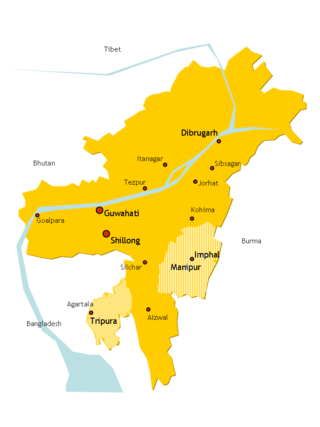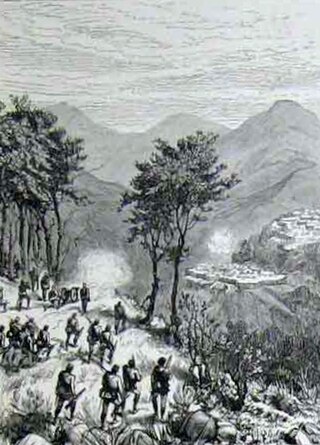
Mizoram is a landlocked state in northeastern India, with Aizawl as its capital and largest city. It shares 722-kilometre (449 mi) of international borders with Bangladesh to the west, and Myanmar to the east and south, with domestic borders with the Indian states of Assam, Manipur, and Tripura. It covers an area of 21,087 square kilometres which 91% of the area is covered by forests, making it the most heavily forested state in India. With an estimated population of 1.25 million in 2023, it is the second least populated state in India. With an urbanisation rate of 51.5% it is the most urbanised state in northeast India, ranking fifth in urbanisation nationwide. One of the two official languages and most widely spoken tongue is Mizo, which serves as a lingua franca among various ethnic communities who speak a variety of other Tibeto-Burman or Indo-Aryan languages. Mizoram is home to the highest percentage of scheduled tribes in India, with the Mizo people forming the majority.

The Mizo people, historically known as the Lushais, are a Tibeto-Burman ethnic group native to the state of Mizoram in India and neighbouring states of Northeast India. They speak the Tibeto-Burman language of Mizo, the official language and lingua franca of Mizoram. The state is the second most literate state in India, at more than a rate of 90%.

The history of Mizoram encompasses the history of Mizoram which lies in the southernmost part of northeast India. It is a conglomerate history of several ethnic groups of Chin people who migrated from Chin State of Burma. But information of their patterns of westward migration are based on oral history and archaeological inferences, hence nothing definite can be said. The recorded history started relatively recently around the mid-19th century when the adjoining regions were occupied by the British monarchy. Following religious, political and cultural revolutions in the mid-20th century majority of the people agglomerated into a super tribe, Mizo. Hence the officially recognised settlement of the Mizos became Mizoram.

Champhai is the third largest town in Mizoram, northeast India and is one of the oldest settlements founded by the Mizo people, that initially served as a capital for the Hmar dynasty. Located near the India–Myanmar border facilitates cross-border trade, it serves as a hub for trade and commerce in the region.

The Kuki people, or Kuki-Zo people, are an ethnic group in the Northeastern Indian states of Manipur, Nagaland, Assam, Meghalaya, Tripura and Mizoram, as well as the neighbouring countries of Bangladesh and Myanmar. The Kukis form one of the largest hill tribe communities in this region. In Northeast India, they are present in all states except Arunachal Pradesh. The Chin people of Myanmar and the Mizo people of Mizoram are kindred tribes of the Kukis. Collectively, they are termed the Zo people.
William Williams was a Welsh Presbyterian missionary to Khasi Hills, northeast India, in the late 19th century. He was a son of a ship captain in Nanternis, a small village in Wales. Following his father's footstep he became a sailor for five years. Then he took a profession in carpentry for two years. After graduating in theology from East London Missionary Training Institute he became a pastor. Pursuing his ambition he became a missionary of the Welsh Calvinistic Methodist Foreign Mission to Khasi people in India from 1887 until his death. He died of typhoid in 1892.

The British Indian Army Lushai Expedition of 1871 to 1872 was a punitive incursion under the command of Generals Brownlow and Bourchier. The objectives of the expedition were to rescue British subjects who had been captured by the Lushais in raids into Assam—including a six-year-old girl called Mary Winchester—and to convince the hill tribes of the region that they had nothing to gain and everything to lose by placing themselves in a hostile position towards the British Government.

Mary Winchester, or Zolûti to Mizos later Mary Innes Howie, (1865–1955) was a Scottish girl who was captured and held hostage by the Mizo tribes of Mizoram, India, in 1871, and rescued by the British expedition in 1872. This historic event marked the beginning of British rule in Mizoram that lasted until the Indian Independence in 1947. Indirectly, it also paved the way for Christian missionaries to introduce Christianity among the Mizos.

The history of Christianity in Mizoram covers the origin and development of all forms of Christianity in Mizoram since the British occupation at the end of the 19th century until Indian Independance. Christianity arrived due to British intervention in tribal warfare, raids of British plantations. The ensuing punitive British military expedition was called the Lushai Expedition of 1871. The subsequent annexation of the erstwhile Lushai Hills to the British Empire opened the gateway for British Christian missions to evangelise the Mizo people.

The culture of the Mizo people has been heavily influenced by Christianity during the colonial era of the British Raj and the rise of Mizo nationalism with the Mizo Insurgency of 1966-1986. Mizo culture is rooted in the arts and ways of life of Mizos in India, Bangladesh and Myanmar. Mizo culture has developed in plurality with historical settlements and migrations starting from Southern China to the Shan states of Burma, the Kabaw valley and the state of Mizoram under the British and Indian administrations.

British rule in the Lushai Hills, spanning from the late 1889 to the 1947, commenced with the Chin-Lushai Expedition of 1889-90 leading to the formal establishment of the two administrative districts in 1889 and continued through the integration of the regions into the province of Assam with both districts being merged as the Lushai Hills until India gained independence in 1947.
William McCulloch (1816–1885) was a British army and political officer in India. He served as the Political Agent for the Manipur Kingdom, a de facto British protectorate on the border with Burma, for a period of 27 years. He acquired an intimate knowledge of the land and the people of Manipur, publishing a book, Account of the Valley of Munnipore and of the Hill Tribes, which has been regarded as authoritative by later writers.

Mizo chieftainship refers to the system of chieftainship used by the Mizo people, which historically operated as a gerontocracy. The chieftain system persisted among the various clans and tribes from the precolonial era through to the British colonial period and Indian independence briefly. The Mizo Union advocated for abolishing chieftainship in Mizoram. The chieftainships of Mizoram were eventually disbanded with the Assam-Lushai District Act in 1954.
Ropuiliani was the first recorded Mizo chieftess in history during British colonial rule in the Lushai Hills. She is remembered for her resistance against British colonial forces after the death of her husband, Vandula. She was the chieftess for Denlung and eight other villages, near present-day Hnahthial in Mizoram. She died in confinement at a prison in Rangmati, Bangladesh on 3 January 1895.
Suakpuilala, known by the British as Sukpilal, was a Lushai chieftain from the Sailo clan who held considerable influence over the western Lushai Hills. Sukpilal conducted a series of raids in British tea plantations and entered a diplomatic relationship with the British soon after. He was also a patron of bazaars and riverines established in the Lushai Hills as the first official trade channels. A defender of his sovereignty, Sukpilal's influence in the Lushai Hills was used by the British for mutual benefits.
Lalchhuaklala, known by the British as Lalchukla was a Lushai chieftain of the Paite clan. He is known for being one of the earliest chiefs to interact with the British through raiding. Lalchukla was a close associate of Hill Tipperah in following the diplomacy of his father Laroo. Lalchukla's raid of Kachu Bari saw British retaliation which led to him being caught. His trial was under English common law, and he was sentenced to life in captivity with deportation. Lalchukla would surrender under the assumed condition that he wouldn't be held captive or executed. Upon deportation from his settlement, many Lushai chiefs viewed this as a breach of faith and a source of resistance to cooperating with the British.

Zakapa, also known as Jacopa, was a Lushai chieftain of the Fanai clan and ruled the Vanlaiphai villages in present-day southern Mizoram. He is best known for his participation in the Lushai Rising.
Khalkam was a Lushai chief of the 19th century. He is known for being the son of Sukpilal and for being an enemy of the British, which led to the Lushai Rising. Khalkam was deported to Hazaribagh jail after British capture, where he committed suicide with his brother Lengpunga.
Lalburha also known as Lalbura was a Lushai chief in the Eastern Lushai Hills. Lalbura is recognised for being the third son of Vonolel and resisting the British after the annexation of the Lushai Hills in the Chin-Lushai Expedition.
The Lushai Expedition of 1869 was an abortive punitive expedition against Sukpilal and Kanai Singh. It was arranged by the deputy commissioner of Cachar, John Edgar and led by Colonel Nuthall. Factors such as weather, unpreparedness and diplomatic overtures led to the retreat and failure of the expedition.













